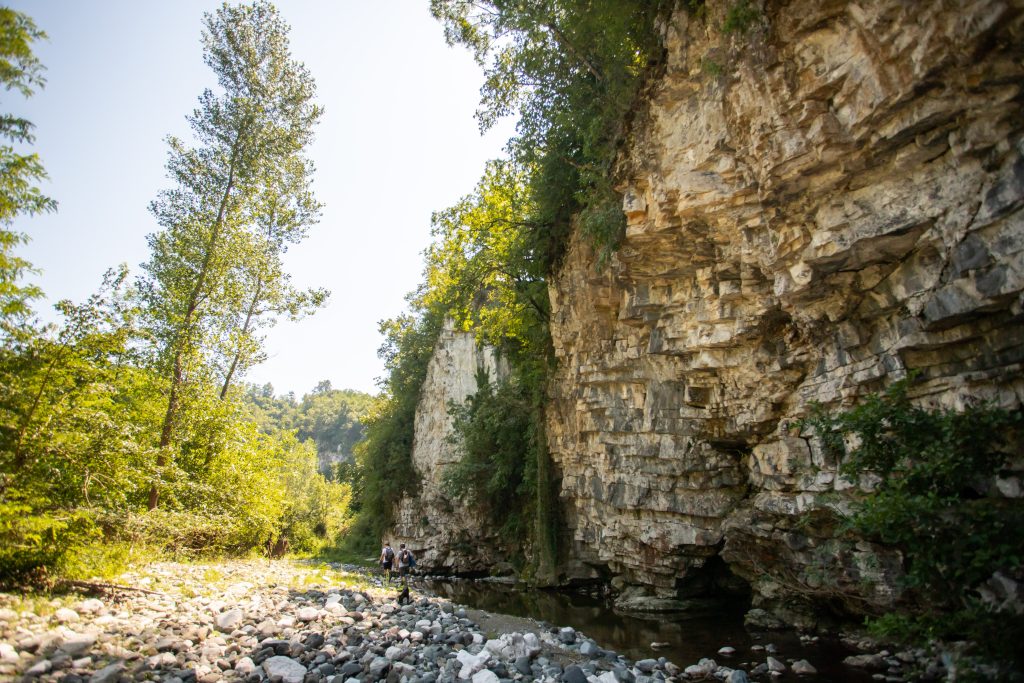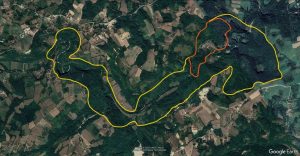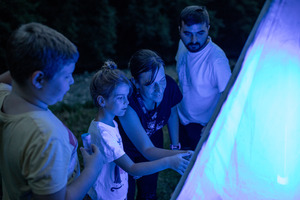As part of the project “Citizens for SDG 15.1” financed as part of the 1st I MPETUS’ acceleration program (EU Horizon project no. 101058677), in 2023 we investigated the area of the Ribnica gorge. The goal of the research was to obtain as much data as possible about the living world and thus to check whether the area’s biodiversity is large enough, so that we could propose the expansion of the Nature Monument Ribnica. We focused on the area that stretches between the two most famous caves: Ribnica Cave in the village Paštrić and Salitrene Cave in the village Brežđe. Now, let’s get acquainted with this area, why it is so important that we are focused on this area from 2023.

About the Ribnica Gorge:
The Ribnica River belongs to the Kolubara basin and flows through the municipality of Mionica along its entire length. The area of the Ribnica river basin is 115 km2. It originates from the rivers Manastirica and Paklešnica in the village of BrežđE (locality Kozomor). In one part of the river there is a karst, through which Ribnica breaks through a gorge about 10 kilometers long. The influence of the moderately continental climate is noticeable. The Ribnica River is part of the Holarctic Floristic Area, Eurosiberian Subregion.
Why Did We Decide to Work Exactly in This Area?
Serbia has a small percentage of protected areas and therefore it is necessary to expand existing and protect new areas. Several authors have pointed out in their professional papers that the area under protection in Ribnica is insufficient and that the gorge itself, its biodiversity and geodiversity should be protected to a greater extent.
The biogeographic characteristics of the canyon-gorge valley of the Ribnica river are described in more detail in the reference Stanojević, 2009. We quote the most important sections from this publication: “The entire course of the Ribnica river as well as a large part of the gorge is not under protection, but only a smaller sector of the gorge around the Ribnica cave with an area of 28 ha. Greater and better protection of this understudied and very rich gorge should not require great efforts, because the entire area with its biogeographic features is still preserved. but if there is no progress in terms of conservation and protection, those rare species will disappear. Based on this brief analysis, the area of the canyon-gorge of the river Ribnica really represents a very interesting and valuable place. As a refugial habitat of certain plants and animals, more detailed and involved studies, marking and labeling of the site are necessary in order to the Ribnica gorge received its rightful and appropriate status”.

Other authors also emphasized the need for greater protection of this area, among other things, because of its exceptional speleological heritage. On the stretch from Paštrić to Kozomor there are as many as 18 speleological objects, the length of which ranges from 4 to 255 meters (Lazarević, 1996). A large number of speleological objects on only 4 km of the river represents a kind of attraction, but also requires increased efforts to protect the area in question (Nikić, 2011).
Current literature data indicate the existence of a significant number of species protected at the national and international level, including 15 species of bats (Petrović, 1983).
The ecological movement was born in the surroundings of this gorge. Therefore, this is not only a story about science, but also a personal story of our members. The river where we learned to swim. But we will write about this in some other occasion…
References
- Lazarević, R. 1996. Valjevski kras. Pećine, jame, kraška hidrografija. Srpsko geografsko društvo,Beograd. 219 pp.
- Nikić, Z. 2013. Model zaštite speleoloških objekata na primeru doline Ribnice od Brežđa do Paštrića = A model of cave conservation on the case example of the Ribnica valley from Brežđe to Paštrić. Zbornik radova 7. simpozijuma o zaštiti karsta, Bela Palanka, 2013. = Proceedings [of] 7th Symposium on Karst Protection , 89-94.
- Petrovic, P. 1983. Prilog poznavanju ljiljaka – Chiroptera, Mammalia – Ribničke pećine kod Valjeva (Contribution to the knowledge of the bat fauna in the Ribnicka pecina Cave, nr. Valjevo). Drugi simpozijum o fauni SR Srbije, Beograd.
- Simić, S. 2008. Vode Valjevske Kolubare – integralni deo zaštićenih prirodnih dobara. Zaštita prirode, 85/1-2: 53-70.
- Stanojević, D. 2009. Biogeografske osobenosti kanjonsko klisurastog dela doline reke Ribnice i njihova adekvatna zaštita. Zbornik radova-Geografski fakultet Univerziteta u Beogradu, 57.
- Vasiljević, B. 1993.Predlog za stavljanje pod zaštitu spomenika prirode Ribnica kao prirodnog dobra odizuzetnog značaja. Beograd: Zavod za zaštitu prirode.



